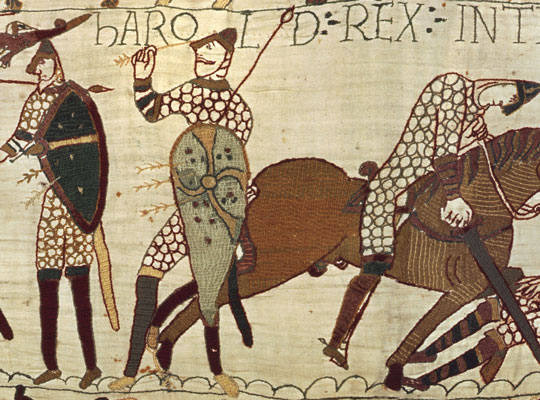Significance of Battle Abbey and battlefield
The Battle of Hastings, arguably the most decisive battle ever fought on English soil, had a profound and lasting impact on England. The well-preserved battlefield, the substantial remains of the great memorial abbey built on the site, and the historic town of Battle created to serve it are tangible and vivid reminders of the events of 1066.

The Battle of Hastings
This is the site of what is probably the most famous battle in England’s history. In popular imagination 1066 is the date of the last successful invasion of England, the year in which William, Duke of Normandy, defeated England’s Saxon army, killed the king, Harold, and seized the throne. The battlefield survives remarkably intact.
William the Conqueror’s victory imposed a Norman ruling class, and led to the introduction of the common law. A huge building campaign designed to impose and emphasise Norman rule saw the widespread construction of many castles, cathedrals, abbeys and churches.
Royal Foundation
Battle Abbey is a remarkable contemporary memorial to the bloodshed of the Norman Conquest. It was a royal foundation and the first post-Conquest religious house established in England. Because of the king’s generous endowments, it became one of the richest monastic houses in England.
In addition, the circumstances of its creation, and King William’s specific instruction to locate the high altar of its church to mark the precise spot where Harold met his death, are unique.
Abbey Site and Buildings
Owing to the location of the Battle of Hastings, Battle is a rare example of an English abbey on a sloping hilltop site rather than on the more sheltered and level ground generally favoured by monastic communities.
The problems of building on such a site are particularly reflected in the east range of the cloister, where the southern end had to be erected over a massive (and extremely well preserved) vaulted undercroft to ensure that the first-floor dormitory was on a level with the abbey church.
The 14th-century gatehouse is one of the finest entrances to an abbey in England. The entrance to the first-floor room has elaborate defensive features. However, rather than having a military use, it is likely that these were intended to impress and intimidate, and that the gatehouse had ceremonial and administrative functions.
Post-Monastic History
The transformation of Battle Abbey into a country estate in 1538 preserved largely intact the abbot’s house and the heart of the former monastic lands, including the battlefield site.
Battle was an important centre of post-Reformation Catholicism, especially during the late 16th and early 17th centuries when it was the residence of Magdalen, the Dowager Viscountess Montague. Battle is reported to have had a well-appointed chapel for Catholic worship, the like of which was ‘not to be seen in all England besides’.[1]
Between the 18th and the 20th centuries the Webster family and the Duke and Duchess of Cleveland made significant additions, including stables, a dairy, an ice house, gardens and a library wing to the former abbot’s house. Despite a serious fire in 1931, this west range is still one of the most complete abbot’s houses remaining in England.
Although the abbey church was destroyed about 1539 and the monastic kitchen was demolished in 1685, most of the rest of the monastic buildings were simply left to decay. Uncontrolled removal of stone for other buildings (robbing) does not seem to have been a major factor here. As a consequence, more of the monastic buildings survive at Battle Abbey than at most other similar sites in southern England.
Abbey and Town
The town of Battle, created to serve the abbey, still retains much of its early medieval street plan. Several houses flanking the High Street still have their original tenement plots that once backed onto open land. In Upper Lake a surviving row of nine Wealden hall houses was constructed as an investment by the abbey between 1460 and 1477.[2]
READ MORE ABOUT BATTLE ABBEY AND 1066 BATTLEFIELD
Footnotes
1. AC Southern (ed), An Elizabethan Recusant House, comprising the Life of Lady Magdalen Viscountess Montague (1538–1608), translated into English from the Original Latin of Dr. Richard Smith, Bishop of Chalcedon, by Cuthbert Fursdon, OSB in the year 1627 (London, 1954), 42.
2. D Martin and B Martin, A Selection of Dated Houses in Eastern Sussex, 1400–1750: Historic Buildings in Eastern Sussex, 4: Robertsbridge, The Rape of Hastings Architectural Survey (1987), 16.